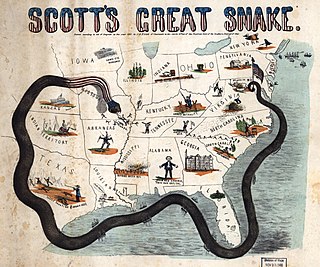The first USS Sonoma was a sidewheel gunboat that served in the United States Navy during the American Civil War. She was named for Sonoma Creek in northern California, Sonoma County, California, and the town of Sonoma, California, that in turn were named for one of the chiefs of the Chocuyen Indians of that region.

CSS David was an American Civil War-era torpedo boat. On October 5, 1863, she undertook a partially successful attack on USS New Ironsides which was participating in the blockade of Charleston, South Carolina.

USS Patapsco was a Passaic-class ironclad monitor in the United States Navy during the American Civil War. She was named for the Patapsco River in Maryland.

The first USS Seminole was a steam sloop-of-war in the United States Navy during the American Civil War.

The Union blockade in the American Civil War was a naval strategy by the United States to prevent the Confederacy from trading.

USS Mahopac (1864) was a Canonicus-class monitor built for the Union Navy during the American Civil War. The vessel was assigned to the James River Flotilla of the North Atlantic Blockading Squadron upon completion in September 1864. The ship spent most of her time stationed up the James River where she could support operations against Richmond and defend against sorties by the Confederate ironclads of the James River Squadron. She engaged Confederate artillery batteries during the year and later participated in both the first and second battles of Fort Fisher, defending the approaches to Wilmington, North Carolina, in December 1864 – January 1865. Mahopac returned to the James River after the capture of Fort Fisher and remained there until Richmond, Virginia was occupied in early April.
USS Home was a large steamship purchased by the Union Navy during the American Civil War. She was placed into service as a hospital ship assigned to support the fleet blockading the ports of the Confederate States of America.

USS Unadilla was a Unadilla-class gunboat built for service with the United States Navy during the American Civil War. She was the lead ship in her class.

The USS Harvest Moon was a steam operated gunboat acquired by the Union Navy during the American Civil War. She was used by the Navy to patrol navigable waterways of the Confederacy to prevent the South from trading with other countries.
USS Clover was a steam gunboat acquired by the Union Navy during the American Civil War. She was used by the Navy to patrol navigable waterways of the Confederacy to prevent the South from trading with other countries.
USS Laburnum was a steamer acquired by the Union Navy during the American Civil War. She was used by the Navy as a tugboat and dispatch boat to serve Union ships on blockade duty.

USS Lodona was a British steamship of the same name captured by the Union Navy during the American Civil War. She had been built in England for shipowner Zachariah Pearson and attempted to break the United States' blockade of Confederate ports. USS Lodona was used by the Navy to patrol waters off those ports. After the war she returned to commercial ownership.
USS Alpha was a side wheel paddle steamer acquired by the Union Navy during the American Civil War.
USS Wamsutta was a steamer constructed for service with the Union Navy during the American Civil War. She was used by the Union Navy as a gunboat in support of the Union Navy blockade of Confederate waterways.

The first USS Wanderer was a high-speed schooner originally built for pleasure. It was used in 1858 to illegally import slaves from Africa. It was seized for service with the United States Navy during the American Civil War. In U.S. Navy service from 1861 to 1865, and under outright U.S. Navy ownership from 1863 to 1865, she was used by the Union Navy as a gunboat, as a tender, and as a hospital ship. She was decommissioned, put into merchant use, and lost off Cuba in 1871.
USS G. W. Blunt was a Sandy Hook pilot boat acquired by the Union Navy during the American Civil War in 1861. See George W. Blunt (1856) for more details. She was used by the Union Navy as a gunboat as well as a dispatch boat in support of the Union Navy blockade of Confederate waterways.
USS George W. Rodgers was a schooner captured by the Union Navy during the American Civil War. She was initially intended to be used as part of the stone fleet of sunken obstructions; however, she was retained and used as a picket boat and dispatch vessel and, later, as a survey ship, concentrating her efforts in the waterways of the Confederate South.

USS Geranium was a steamship acquired by the Union Navy during the American Civil War for the purpose of using her as a tugboat in support of Union ships on the blockade of Southern waterways. However, in addition to her tug duties, she also served as a picket ship, dispatch boat, supply runner and other duties assigned to her by the Navy.

USS Hope was a 19th-century wooden yacht schooner, designed and built in 1861 by Henry Steers for Captain Thomas B. Ives of Providence, Rhode Island. She was acquired by the Union Navy during the American Civil War. She was placed into service as a gunboat assigned to support the fleet blockading the ports of the Confederate States of America. However, at times, Hope was assigned extra tasks, such as that of a dispatch boat, supply runner and salvage ship. She was a pilot boat from 1866 to 1891 and in 1891 she was replaced by the Herman Oelrichs, when the Hope was wrecked ashore the Sandy Hook Point.
The third USS Union was a heavy (1,114-ton) steamer with a powerful 12-inch rifled gun purchased by the United States Navy during the American Civil War.










